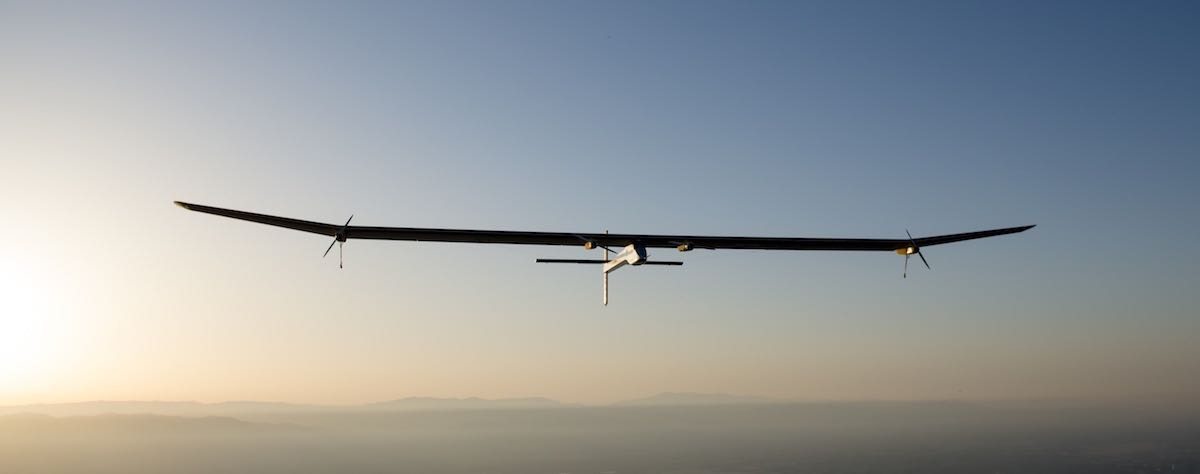If a few years ago someone had told us that it was possible to power an airplane solely and exclusively by solar energy, we would not have believed it. Today this is already an incipient reality, at an experimental level of course, but it can mean a before and after in the history of aviation.
First project, the Solar Impulse
It all started in 2005, with the Solar Impulse. A Swiss project led by Bertrand Piccard – son of Jacques Piccard, a pioneer in reaching the maximum sea depth aboard the Trieste bathyscaphe – and André Borschberg, whose goal was to create an aircraft that could fly with almost unlimited autonomy day and night thanks to the coverage on both wings of the plane of photovoltaic cells responsible for charging the batteries to provide power to the entire vehicle, engines and instruments.
The prototype had a wingspan of 71’9 meters and a length of 22’4 meters. To achieve the stated objective, the aircraft was made of lightweight materials to reduce its weight. Designed to be operated by a single pilot, after modifications, its final weight was 2,300 kg. Its wings were covered by 15,000 photovoltaic cells that allowed it to generate enough energy to drive its four 13 kW (17.4 HP) motors.
This project was successfully concluded after several test flights, including overnight trips, helping to open the door for aviation to take a new course towards a much more sustainable future in the near future.
It should be noted that this prototype managed to make a flight of 26 hours in a row, which is why, as a result of this, in 2015, several projects were born from which some details should also be highlighted to understand the present of aviation and, above all, their future, so let’s see them.
Fly around the world with Solar Impulse 2
After this first feat, one of the most important projects to highlight, and that was born as a result of the first, is the Solar Impulse 2, with which a plane powered by solar energy capable of flying around the world is proposed.
Although aircraft powered by combustion or jet engines are currently faster than those that use solar energy, they are also much more polluting, which is why a new course for the future of aviation is beginning to be set. . After all, the plane of the Wright brothers, forerunners of modern aviation, today would be classified as ultralight (ULM) and on its first flight it did not exceed the total length of a modern Airbus A380.
The Solar Impulse 2 flight took place in 2015, and was designed with 17 stops around the world, with a total of about 35 thousand kilometers traveled. For this, the wings of the plane were equipped with 17 thousand solar panels to capture solar energy.

The flight began on March 9, 2015 in Abu Dhabi (United Arab Emirates) with its creators as pilots and ended 505 days later, having. Successfully completed his journey around the world.
This project would not have been possible without its predecessor, Solar Impulse, a project on which its creators, André Borschberg and Bertrand Piccard, were working for more than twelve years.
Solar Stratos
At this point, it is worth highlighting another of the most important and ambitious projects of solar energy in aviation: the Solar Stratos.
This project was born in 2015 with the aim of making a trip ascending to the stratosphere, that is, between 12 and 50 kilometers of altitude, with a two-seater plane powered by solar energy. In this case, its founder, Raphaël Domjan, wants to reach an altitude of 25,000 meters. To achieve this, the wings and tail of the plane have been covered with 22 m2 of solar panels in order to provide power for the plane.
However, this project has some difficulties, such as the temperature at which both the plane and the pilot will have to withstand. We must bear in mind that throughout the trip, which lasts for 6 hours, the temperature to which the plane will be exposed is up to -70ºC. Solar radiation reaching the upper layers of the atmosphere, with high concentrations of UV, gamma and X rays also represents a serious obstacle.
To deal with this problem, the cockpit will be thermally optimized to guarantee the safety of the pilot, who is also the creator of the project. The first stratospheric flight of its kind is scheduled for 2022.

In a previous article we talked about the fuels of the future of aviation, and it is that hybrid or electric engines are among the novelties that in the short-medium term will cross the skies. Among them, the project in which Easyjet is embarking, which is preparing an electric plane with capacity for 186 passengers.
Testing of the Wright Electric-designed engine is scheduled to begin this year, with the first test flights in 2023. EasyJet thinks that if all goes according to plan, the aircraft could enter service in 2030.

Easyjet prepares an electric plane with capacity for 186 passengers
Over the last few years, aviation has taken a different course from the one it had taken until today in order to achieve a much more sustainable future. Will future pilots pilot 100% solar or electric aircraft in the future? Only time and technology have the answer.
As Piccard, creator of Solar Impulse, said after having successfully carried out his project: “The world is going in the wrong direction. We are destroying the planet, nature and natural resources. We must do things differently.”
